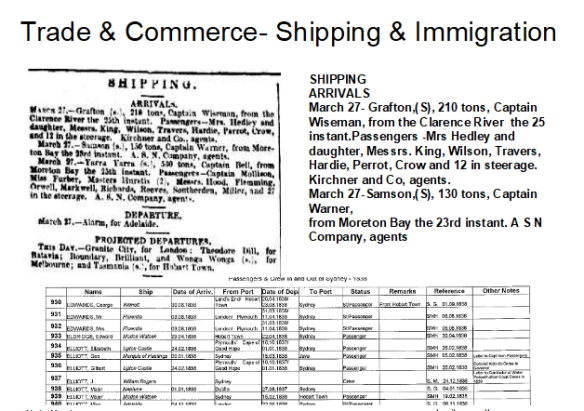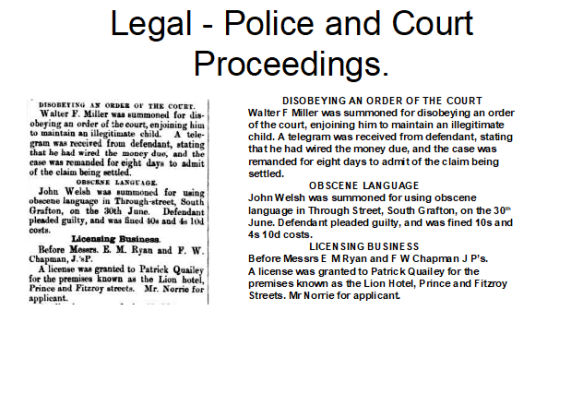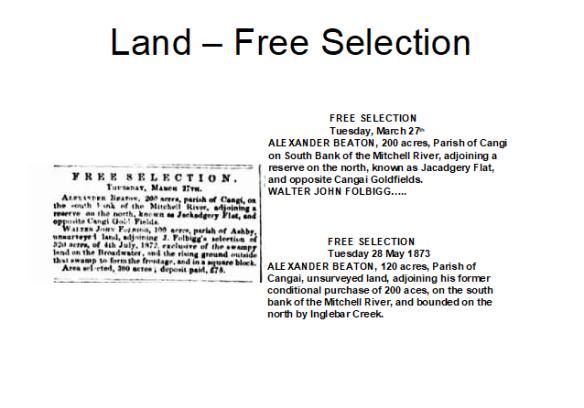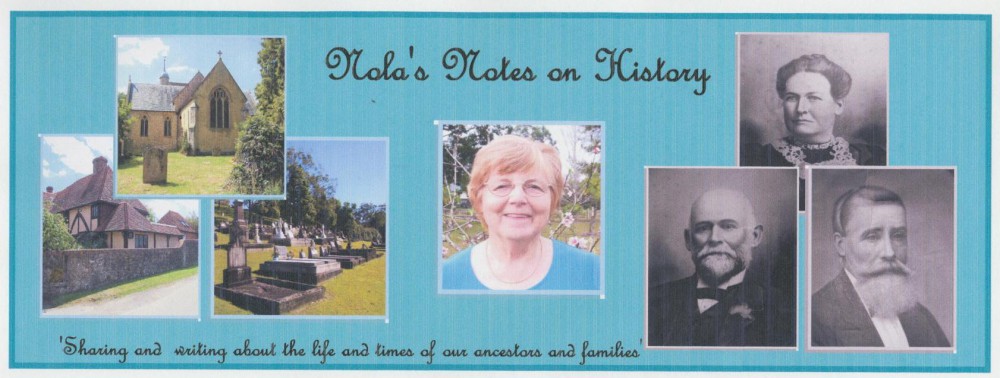As much as I love those early Sydney newspapers, it is the Provincial or Regional newspapers I am most passionate about, as it is those newspapers which hold within their pages the more personal history of an area and its people.
Although a newspaper had begun in the Hunter Valley in 1841, it was the Maitland Mercury which began in January 1843 that became a great success story. It began as a weekly and became a bi-weekly in 1846 to a tri-weekly in 1856. It was so successful that in 1893 it was a daily. It covered the news not only of the whole Hunter Valley but it had its own ‘correspondents’ reporting throughout the whole of northern and western New South Wales. Later when many of these towns began to produce their own newspapers the Maitland Mercury continued to spread the news by publishing ‘extracts’ from these publications. This becomes a very important consideration when the ‘original’ issues of these publications have not survived.
The Provincial newspapers of NSW to follow the Maitland Mercury were:
Brisbane Courier-1846:
Bathurst Free Press and Mining Journal-1848;
Goulburn Herald- 1848:
Armidale Express-1856;
Newcastle Chronicle-1858
Clarence and Richmond Examiner-1859.[This later became the Daily Examiner]
It is from the last of these I propose to examine more thoroughly and give examples from. This newspaper has recently been digitized and made available through Trove. However, a much more complete set of newspapers survive in hardcopy and are housed at Grafton. In an extensive study of this newspaper between 1859-1869, I found there were more than 160 issues not microfilmed and made available on-line through Trove. Of those microfilmed nearly 200 issues were missing a supplementary page that has survived in the hardcopy.
Other newspapers for the Grafton area included:-
- The Grafton Argus
- The Observer
- The Grip
- The Clarion
- The Clarence Advocate (Maclean)
Only short runs and occasional copies have survived. All known surviving copies of the these newspapers have been microfilmed. Some of these can also be found on in the Historical Newspapers on Trove.
Please also note many other North Coast newspapers can be found on Trove, including those for Casino, Kyogle, Lismore, Murwillumbah, Brunswick Heads and Mullumbimby.
From the earliest days newspapers were in the business of information and were organized in an orderly fashion under ‘headings’ rather than ‘headlines’, so that a pattern emerges which allows researching newspapers easier than one at first might assume. In each issue the headings usually appeared on the same page and in the same column which allows for scanning with the eyes rather than reading every word in print. These headings could roughly be grouped into:
- News of events and places
- Personal Notices and Items
- Trade and Commerce
- Land
- Legal
- Social
All these to varying degrees have value to the family historian. To illustrate this I propose to take some of these headings and show the scope and value of each to the family historian.
News of Events and Places- This is of course is always of interest to the local and family historian and includes a wide range of topics such things as flooding, mining and shipping disasters or gold discovery, launching of a ship, opening of a school, or railway line and station.
Personal Notices- Birth, Death and Marriage Notices are perhaps one of the most valuable sources sort by family historians. These fall into three kinds.
Firstly an event which took place locally, secondly of an event somewhere in Australia, and thirdly of one overseas in another country which had some family connections in Australia.
Even if you have a baptism and or birth certificate; marriage certificate or burial and or death certificate it is always worth checking to see if there was a corresponding notice in a newspaper. Very often extra information is given which is important and not likely to be found in other sources. Let me show you an example
You will find other notices and items of value around the wedding particularly in the early to Mid 20th Century. Reports of ‘Tin-kettling, Kitchen teas, Wedding receptions, etc. Are you fortunate enough to have a black and white or sepia wedding photo of an ancestor’s wedding group? Have you found a report in a newspaper that named and described the clothes of the wedding party, including the colour of the fabric? No colour photos in those days and this may be the only way you can find the colour of the bridesmaid’s dresses. Often there was also a list and description of the wedding gifts and who gave them.
Other useful newspaper items and notices concerning death are obituaries, death reports, inquests, funeral notices, and probate notices.
Of course, Obituaries have always been of value to the family historian and are much sort after. The true obituary as we know it didn’t really appear until the second half of the 19th Century except for the wealthy. Sometimes an obituary was not entered for the husband, but was for the wife, especially if she died many years after the husband. Sometimes circumstances concerning the husband’s death were given, which is very valuable if the death was before 1856.
Some interesting ones in Grafton were those of Mrs. Mary Greenwood (formerly Bawden) who died in May 1873 her husband having died in 1841, and Mrs. Mary Matilda Hann, who died in June 1882, whose husband died in 1857.
After 1900 obituaries became more frequent and during the period 1920-60 were usually very good. However, it must be noted that ‘convict background’ was ‘covered-up and be aware that sometimes information in obituaries can be misleading to the researcher.
Trade and Commerce
I’m sure everyone would be aware how useful advertisements can be when researching local and family history. They cover a wide range from listing goods for sale, the opening of businesses, business partnerships, the opening of new stores, etc.
One of the most useful sections is the Shipping Intelligence and Shipping News sections of the newspapers.

For those who have a maritime connection, the Shipping Intelligence sections of newspapers can be useful in tracing the history of ships and some of their crew.
Or it can help find when people arrived in an area. The above list for Herbert Eggins certainly implies he was settling in the district.
Legal
Then there are Legal items such as – Police and Court Proceedings, Probate notices, divorce cases, formation and dissolution of business partnerships, advertisements of bailiff sales, police, and court proceedings.



Land
For those who settled on the land, there are notices of -Land Grants, Pre-emptive Leases, Conditional Purchases, Conditional Leases, Land Wardens Courts, Property names. Mining Reports

Mining
And for those who had Gold fever there were Mining Reports Social
Social
There were the social aspects of the area in reports and advertisements about – dances, association meetings and gatherings, visitors, and general gossip columns. The Sports Team fixtures, reports of events, team lists, sporting career biographies
Finally, we touch on the education opportunities and reports in the newspaper pages with concerts, P & C Meetings, prize-giving ceremonies, class lists, examination result lists (Leaving Certificate).
I have prepared indexes from Clarence River newspapers to assist family and local historians to find material in these newspapers. These are now out of print but can be found in libraries and family history and local history societies.
They include:-
Clarence River Register No 1 1859-1869: Births, Deaths, and Marriages from the Newspapers
[Nola Mackey,1994,72pp,ISBN 959263144]
Clarence River Register No 2 1870-1879: Births, Deaths, and Marriages from the Newspapers
[Nola Mackey,1994,103pp,ISBN 959263160]
Clarence River Register No 3 1880-1889: Births, Deaths, and Marriages from the Newspapers
[Nola Mackey,1995,134pp,ISBN 959263187]
Clarence River Register No 4 1890-1899: Births, Deaths, and Marriages from the Newspapers
[Nola Mackey,1996,120pp,ISBN 1875840001]
Clarence River Register No 5 1900-1905: Births and Marriages from the Newspapers
[Nola Mackey,1998,36 pp, ISBN 1875840028]
Clarence River Register No 6 1906-1910; Births, Deaths, and Marriages from the Newspapers
[Nola Mackey,1998,114pp,ISBN 1875840044]
Clarence River Register No 7 1900-1905: Deaths and Burials in the Clarence River District
[Nola Mackey and June Kepper,1984,141pp, ISBN095926311X]
Clarence River Register No 8 1862-1869: Land Selection on the Clarence and Richmond Rivers
[Nola Mackey,1998,148pp,ISBN 1875840079]
Clarence River Register No 9 1860-1865: Passengers and Crew In & Out of the Clarence River
[Nola Mackey,2000,Set 3 books 78pp,74pp,36pp,ISBN 1875840095]
Clarence River Register No 10 1866-1869: Passengers and Crew In & Out of the Clarence River
[Nola Mackey,2000,Set 3 books 106pp,108pp,48pp,ISBN 1875840117]
Clarence River Register No 11 1870-1879: Conditional Purchases of Land on the Clarence River
[Nola Mackey,2004,142pp,ISBN 1875840567]
Clarence River Register No 12 1911-1915: Births, Deaths, and Marriages from the Clarence & Richmond Examiner (Grafton)
[Nola Mackey,2005,192pp,ISBN 1875840613]
However again I need to remind you to think about the following when you are assessing the information in these newspapers.
Do not automatically take the published word as gospel, and proof of what happened. Look at the evidence and how it was presented. Reports of Inquests and Court Proceeding are likely to be correct as the evidence is taken under oath, but an obituary or biography of a person’s life may contain untruths and exaggerations.
If there were more than one newspaper being published in the area in a time period look at them all. You will be surprised to learn they will not report the same event exactly the same. There may be more information in one than the other.
Not all newspapers are equal- and there is good reporting and bad reporting and much depends on the editor of the paper at the time.
Newspapers have always been in the business of selling news, but they have always come under the Crown laws concerning slander and misrepresentation of facts. Some owners/editors stretched these boundaries and have found themselves in Court. There have been several newspapers who were sent to the wall and insolvency through court cases concerning slandering opposition newspapers.
Good hunting everyone.
